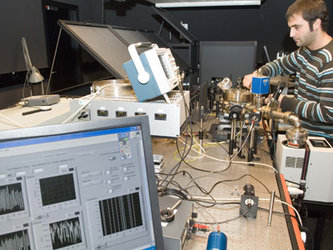What kind of testing does the optics laboratory carry out?
The Laboratory's testing follows the same underlying principles as an optician's eye test, although the tests themselves are far more complex and demanding. Optical properties are determined by physical characteristics so the Laboratory performs geometrical measurements of a test item as well as verification of optical parameters such as its focal length, refractive index, radius of curvature, optical aberrations and wavefront error.
- White-light interferometric microscopy can measure height variations on an optical surface down to the nanometre scale (a billionth of a metre). This test technique is based on the ultraprecise combination of two optical paths so they cohere to create an interference pattern. The slightest change in optical path length as one beam is reflected off a test surface and the interference pattern changes. Multiple measurements can be combined to make a two dimensional surface height map, with applications including the identification of damage done to optical surfaces by laser irradiation.
- One key variable for optical systems is the amount of light being scattered rather than reflected due to polishing imperfections, surface roughness or contamination – more stray light means lower optical efficiency. The Laboratory tests reflectance properties of surfaces – including a specific value called the bidirectional reflectance distribution function (BDRF) - using a high-performance scatterometer. The same measurement technique can also be used to partially assess the efficiency of diffraction gratings used to split light for spectrometers.
- Another important measurement parameter is the wavefront error, determined using an interferometer to compare the 'wavefront' of light extending from the optical device with its ideal wavefront pattern, allowing the evaluation of surface error (or deformation) patterns and the resulting induced optical aberrations.
- Optical image resolution, magnification, contrast (Modulation Transfer Function - MTF) and focus precision (Point Spread Function - PSF) can also be characterised using narrowly-beamed (or well collimated) light sources.










